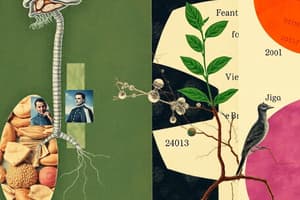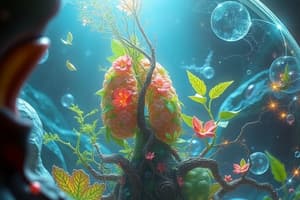Podcast
Questions and Answers
During ______, chloroplasts in plant cells absorb carbon dioxide, water, and light energy.
During ______, chloroplasts in plant cells absorb carbon dioxide, water, and light energy.
photosynthesis
Mitochondria in ______ cells absorb oxygen and glucose to create chemical energy.
Mitochondria in ______ cells absorb oxygen and glucose to create chemical energy.
eukaryotic
The two processes of photosynthesis and cellular respiration demonstrate ______ of matter.
The two processes of photosynthesis and cellular respiration demonstrate ______ of matter.
conservation
Different cell types have different ______ in our bodies.
Different cell types have different ______ in our bodies.
The four levels of organization in a multicellular organism from smallest to largest are cells, tissues, ______, and organ systems.
The four levels of organization in a multicellular organism from smallest to largest are cells, tissues, ______, and organ systems.
Flashcards
Photosynthesis
Photosynthesis
Process in plants using chloroplasts to convert sunlight, carbon dioxide, and water into carbohydrates and oxygen.
Cellular Respiration
Cellular Respiration
Process in eukaryotic cells using mitochondria to convert glucose and oxygen into energy, producing carbon dioxide and water.
Conservation of Matter
Conservation of Matter
Principle stating matter is not created or destroyed, only transformed; atoms remain constant in photosynthesis and respiration.
Cell Variety
Cell Variety
Signup and view all the flashcards
Levels of Organization
Levels of Organization
Signup and view all the flashcards
Study Notes
Photosynthesis and Cellular Respiration
- Photosynthesis uses light energy, carbon dioxide, and water to produce glucose and oxygen
- Chloroplasts are the cell part responsible for photosynthesis
- Cellular respiration uses oxygen and glucose to produce energy (ATP), carbon dioxide, and water
- Mitochondria are the cell part responsible for cellular respiration
Conservation of Matter
- Photosynthesis and respiration demonstrate the conservation of matter
- Atoms are neither created nor destroyed; they are only transformed
Cell Variety
- Different cell types in organisms perform different functions
Levels of Organisation
- Cells are the smallest units
- Tissues are groups of similar cells
- Organs are structures made of different tissues
- Organ Systems are groups of organs working together
Studying That Suits You
Use AI to generate personalized quizzes and flashcards to suit your learning preferences.




